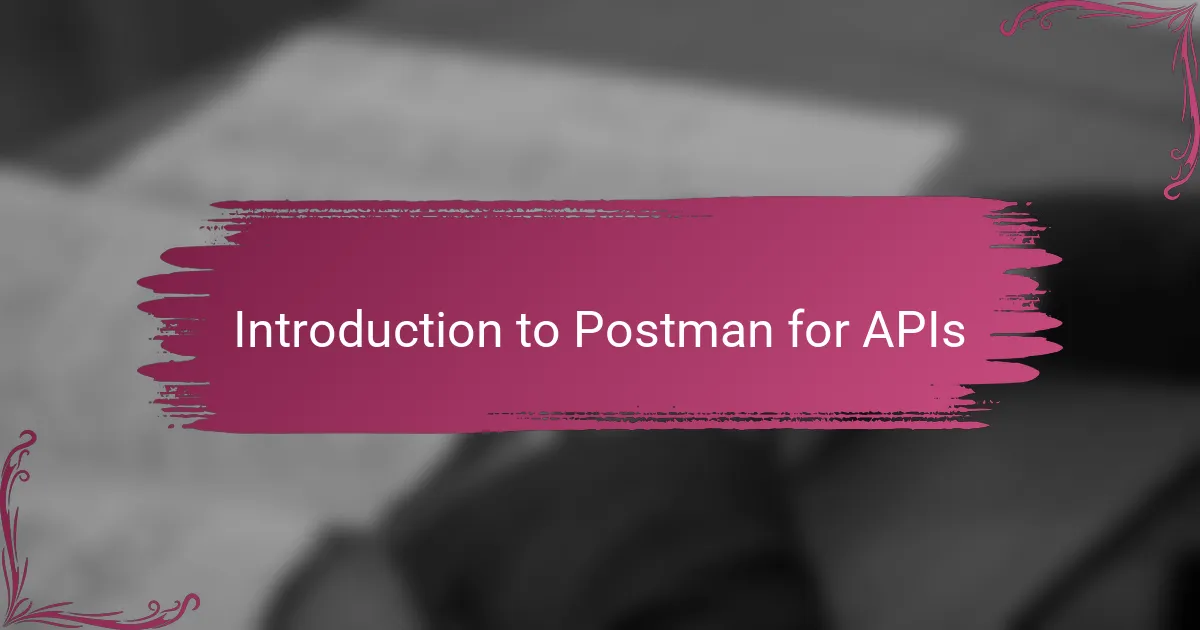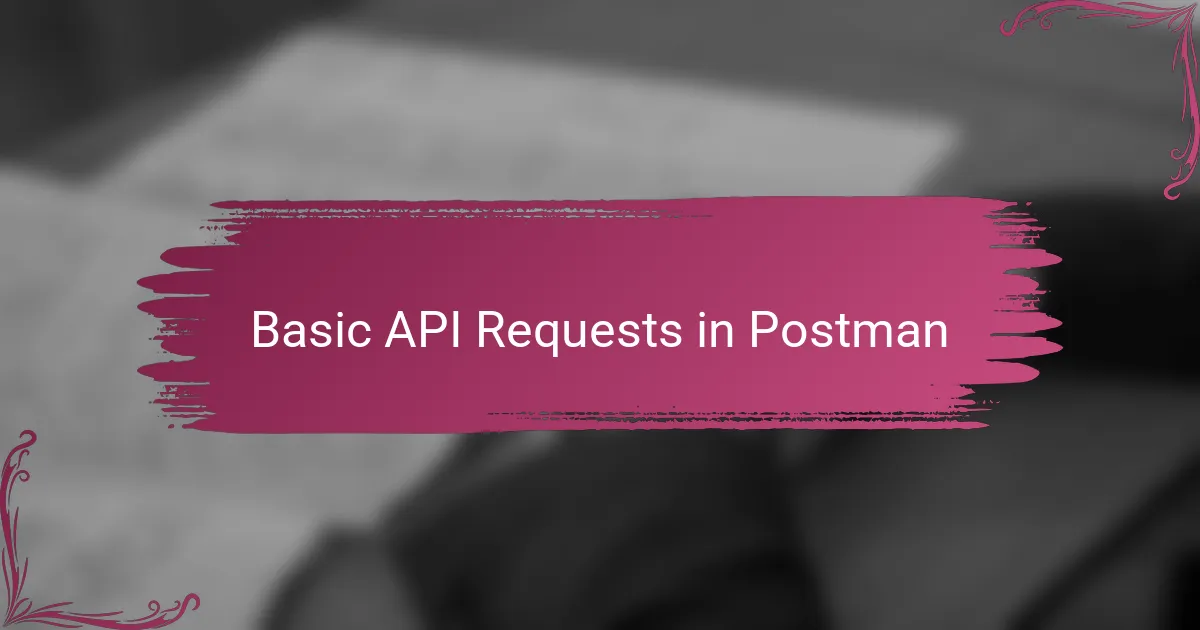Key takeaways
- Postman simplifies API testing by organizing requests into collections and providing a user-friendly interface for managing headers, parameters, and variables.
- Advanced features like automated testing scripts and environment variables streamline workflows and reduce manual errors, enhancing overall productivity.
- Postman’s ability to visualize responses and automate token management significantly eases the debugging process and minimizes frustration.
- Proper organization of requests into named collections and folders transforms the testing experience, making it more efficient and less chaotic.

Introduction to Postman for APIs
When I first encountered Postman, I was amazed at how it simplified testing and interacting with APIs. Have you ever struggled to manually send requests or decipher complex API documentation? Postman acts like a helpful assistant, making these tasks feel straightforward and even enjoyable.
What really struck me was how Postman organizes API requests into collections, which saved me tons of time managing different endpoints. It felt like having a neatly arranged toolbox where everything was just a click away. This intuitive setup gave me confidence to experiment and learn APIs hands-on.
I also found Postman’s ability to visualize responses invaluable—it turns abstract data into meaningful information quickly. Isn’t it frustrating when you have to sift through raw JSON or XML? Postman’s user-friendly interface eased that pain, allowing me to focus on understanding the API rather than wrestling with its output.

Setting Up Postman for API Testing
Getting started with Postman was surprisingly quick for me. I simply downloaded the app, signed up, and was ready to create my first request within minutes. Have you noticed how some tools require endless configuration before you even write a single line? Postman isn’t one of them—it just lets you jump right in.
One thing I appreciated early on was how easy it was to set up environments. Instead of changing URLs or tokens manually every time, I could define variables that adapted with each test. This saved me from needless frustration and kept my workspace clean, which made testing multiple APIs feel less like a chore.
I also remember feeling reassured by Postman’s clear interface for entering headers, parameters, and body data. It’s not just about clicking buttons—it guides you to provide all necessary info without guessing. That hands-on feedback helped me avoid errors and understand the API’s requirements better. Wouldn’t you agree that minimizing guesswork is a huge plus when debugging?

Basic API Requests in Postman
When I first started making basic API requests in Postman, I was impressed by how straightforward it was to send a simple GET request. You just enter the URL, hit send, and voilà—you get the response almost instantly. It made me think, why did I ever spend so much time with curl commands when this process feels so much smoother?
One thing I quickly noticed is how Postman allows you to customize requests with headers and query parameters without hassle. For example, adding authentication tokens or filtering data became a breeze, thanks to its organized input fields. Have you ever fumbled trying to format these details manually? Postman eliminated that headache for me entirely.
Another feature that stood out was Postman’s ability to save these requests for later use. This saved me from repeatedly entering the same information and made testing different endpoints more efficient. Honestly, it’s like having a reliable assistant that remembers all the little details, which kept me focused on exploring the API rather than wasting time on setup.

Advanced Features of Postman
Diving into Postman’s advanced features felt like unlocking a whole new level of productivity for me. One feature that truly stood out was the scripting capability with pre-request scripts and tests. I remember how empowering it was to automate checks and manipulate data on the fly—no longer did I need to verify responses manually or mess with separate tools just to validate my APIs.
The use of environments and global variables took my workflow to a new height, especially when managing multiple stages like development and production. Have you ever tried swapping tokens or endpoints back and forth endlessly? Postman’s environment variables eliminated that tedious back-and-forth, making my testing not only faster but also less error-prone.
Another powerful tool I discovered was the collection runner, which let me execute entire API test suites in one go. It felt like having a personal QA team running through my endpoints while I focused on building features. This automated approach saved me so much time and helped catch issues that I would have missed with manual testing alone.

Common Challenges and Solutions
One challenge I often ran into was managing authentication tokens, especially when they expired frequently. It was frustrating to keep updating them manually, but Postman’s environment variables came to the rescue by automating token refreshes through pre-request scripts. Have you ever wished you could set it once and forget about it? That feature made my workflow much smoother.
Another hurdle was dealing with inconsistent API responses that sometimes broke my tests. Initially, it felt like chasing shadows, trying to understand whether the issue was with my request or the server. Writing test scripts within Postman to check for response validity helped me isolate and quickly identify problems, which gave me much-needed peace of mind.
I also stumbled upon the confusion of organizing hundreds of requests in large projects. At first, finding the right request felt like looking for a needle in a haystack. Creating well-structured collections and folders transformed my experience entirely—it felt like tidying up a cluttered desk and suddenly being able to find everything at my fingertips. Have you tried organizing your Postman workspace this way? It really amplifies productivity.

My Practical Postman Experience
Using Postman in real projects truly shifted how I approach API testing. I remember the first time I chained multiple requests together with scripts; it felt like I’d harnessed real power to streamline repetitive tasks. Have you ever had that moment when a tool just clicks, and suddenly the whole workflow seems so much smarter? That was exactly how Postman transformed my testing routine.
Sometimes, I found myself caught up in the details—tweaking headers, adjusting parameters—but Postman made these steps feel less like chores and more like fine-tuning an instrument. Its intuitive interface gave me confidence, especially when handling complex APIs where one wrong value could derail everything. Don’t you think having that kind of immediate feedback is a game-changer?
What surprised me most was how Postman turned debugging from a frustrating guessing game into a clear, guided process. When a response didn’t match expectations, I could write quick tests or preview the data in ways that highlighted issues instantly. It’s rare to find a tool that not only saves time but also reduces the stress of troubleshooting—Postman did both for me.

Tips for Efficient API Testing
One tip I found invaluable for efficient API testing is to leverage Postman’s automated testing scripts. Instead of manually checking each response, writing small JavaScript tests lets me catch errors early and consistently. Have you ever missed a subtle bug just because you skimmed through the response? Automating checks saved me from those frustrating moments.
Another trick that made my life easier was using environment variables to switch contexts without breaking a sweat. When I moved between staging and production APIs, changing endpoints or tokens felt like flipping a switch rather than hunting down every instance. Isn’t it such a relief when your setup adapts instantly to where you want to test?
Finally, organizing requests into well-named collections and folders transformed the chaos of multiple endpoints into a clear workflow. I used to waste time searching for a specific test, but grouping related APIs logically turned Postman into my personal command center. Have you tried that little organizational habit? It made testing faster and way less stressful for me.